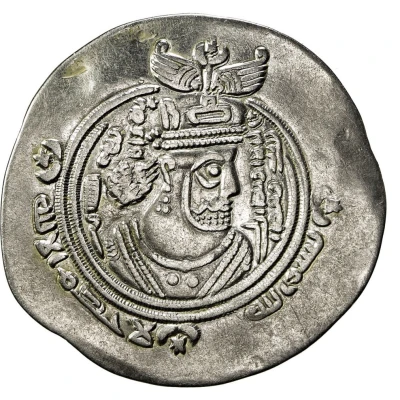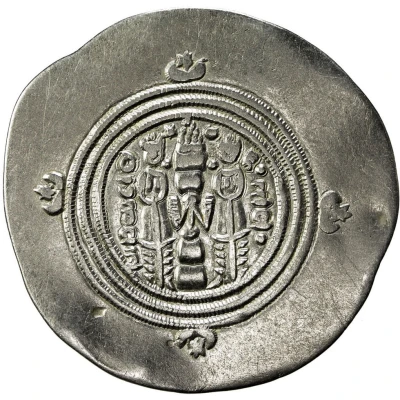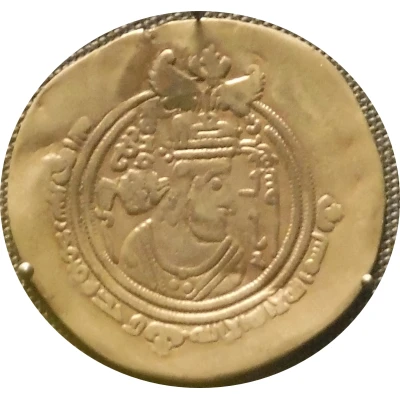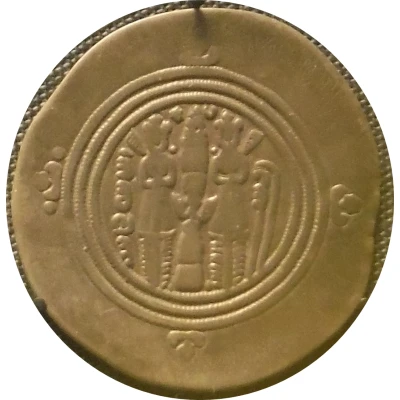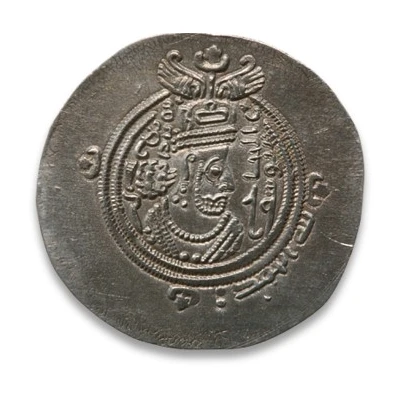
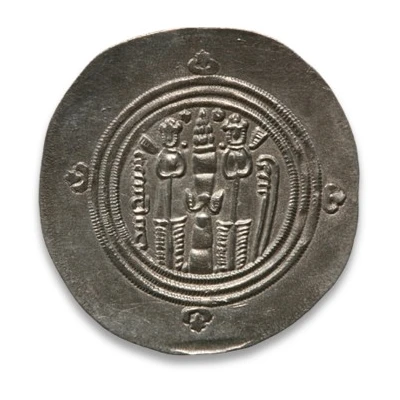

Drachm - al-Hajjaj b. Yusuf Bishapur mint - Umayyad Governors of Iraq - Arab-Sasanian ND
| Silver | 4.21 g | 35 mm |
| Issuer | Umayyad Caliphate |
|---|---|
| Type | Standard circulation coin |
| Years | 696-714 |
| Value | Drachm (1) |
| Currency | Drachm (661-750) |
| Composition | Silver |
| Weight | 4.21 g |
| Diameter | 35 mm |
| Shape | Round (irregular) |
| Technique | Hammered |
| Demonetized | Yes |
| Updated | 2024-10-05 |
| Numista | N#74038 |
|---|---|
| Rarity index | 97% |
Reverse
Field
Sasanian fire altar raised on three steps with an attendant priest or mabedh on either side standing facing, at the top of the flames rising from the altar, on the left a small star and on the right a small crescent
to left downwards, the Pahlawi date HShTAT (80)
on right BISH, the Pahlawi abbreviation for Bishapur
all enclosed within a triple circle.
Outer margin
divided into quarters by stars and crescents at 12:00, 3:00, 6:00 and 9:00
Lettering: BISH
Comment
Historical note
Al-Hajjaj ibn Yusuf was the outstanding personality of the early Umayyad Caliphate. He succeeded in stamping out the revolt of ‘Abd Allah ibn Zubayr, nephew of the Prophet’s wife Aisha, over the accession to the caliphate of Yazid, the son of Mu‘awiya.
In recognition of this the new caliph, ‘Abd al-Malik ibn Marwan, appointed him Viceroy of the Eastern Command and governor of both Kufa and Basra. These positions allowed him to suppress the dissension and strife with which the Caliphate had been beset for many years. It was al-Hajjaj who replaced Pahlawi with Arabic as the official language of the east.
‘Abd al-Malik also enlisted the help of al-Hajjaj in devising the new Umayyad monetary system which was entirely Islamic in character. This drachm is a rare instance when the traditional Arab-Sasanian coinage overlaps with that of the Umayyad reform-style dirham.
While it still bears the bust of Khusraw II, the fire altar and the mint name and date in Pahlawi, the name al-Hajjaj and the words lillah al-hamd (to God be the Praise!) are inscribed in Arabic. Al-Hajjaj was one of the very few Umayyad governors to place his own name in Arabic on his coinage.
The mint name BISH (Bishapur, Sabur in Arabic) is known from 79, 80 and 81 H. This and Darabjird were the two most prolific mints in Iran for both the Arab-Sasanian and post-reform Umayyad coinages.
Interesting fact
One interesting fact about this coin is that it features an image of a crowned caliph on the obverse (front side), which was a distinctive feature of Umayyad coinage during this period. The caliph depicted on the coin is likely to be al-Hajjaj b. Yusuf, who was a powerful governor of Iraq during the Umayyad Caliphate and played a significant role in the Arab-Sasanian Wars. The coin's design and imagery reflect the blending of Arab and Sasanian influences in the Umayyad Caliphate's art and architecture.
